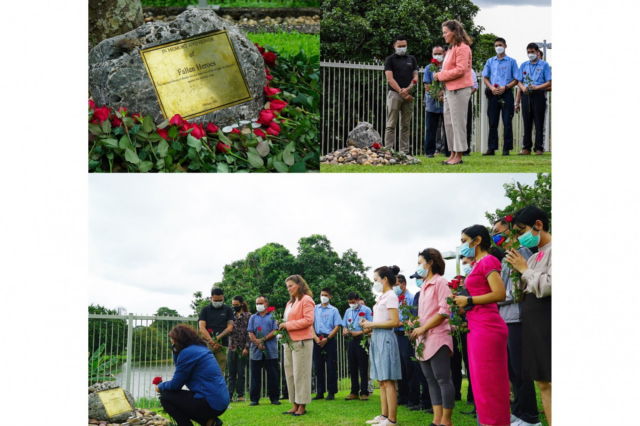Myanmar’s junta has killed nearly 220 prisoners since coup, says watchdog


A vigil for the “fallen heroes” of Myanmar’s revolution is held at the American Embassy in Yangon on October 18, 2021 (US Embassy, Yangon)
Many of the victims were tortured to death, according to the director of the UK-based Burma Human Rights Network
By Myanmar Now
More than 200 people have died in regime custody since last year’s coup, according to the head of a UK-based human rights watchdog group.
Kyaw Win, the director of the Burma Human Rights Network (BHRN), said that the group’s records show that a total of 217 people have been killed during interrogations over the past year and a half.
Most of the victims were members or supporters of the ousted ruling party, the National League for Democracy (NLD), or of People’s Defence Force (PDF) groups formed in the wake of crackdowns on anti-coup protests, he said.
“Some of the PDF members were killed on arrival, while many NLD members were killed after a period of torture,” he told Myanmar Now.
“The actual numbers could be higher than our list indicates,” he added.
Myanmar’s shadow National Unity Government, which also tracks abuses by the junta that seized power in February of last year, had similar findings, according to its minister for human rights, Aung Myo Min.
“More than 200 have been killed after being tortured in interrogation centres. Many of the victims faced extreme physical, mental and sexual abuse before they died,” he said.
He added that most of the victims were under the age of 35, and that NLD lawmakers were among those subjected to torture.
One MP who had been arrested during the Saffron Revolution in 2007 said that human rights violations were routine in military custody.
“I was blindfolded, day and night, for three days and made to sit in a very high chair so that my feet couldn’t touch the ground. Sometimes they kicked me with their boots. I was also forced to kneel on pebbles and small, sharp objects,” he said, recalling his own experience.
According to data compiled by BHRN, more than 80 of those killed in custody since the military takeover died in Sagaing Region, making it the deadliest state or region for political prisoners.
This includes 28 who were killed in the region in July alone, according to the group’s director.
“Some were killed two or three days of their arrest, but most were dead within 24 hours. In some cases, the bodies of detainees arrested the night before were handed over the next morning. Some families didn’t even get the bodies back,” said Kyaw Win.
According to a woman involved in efforts to assist civilians displaced by the junta’s ongoing military operations in Sagaing, many of the victims are not even involved in the conflict.
“Most of the people killed during interrogation were PDF members, but some are just locals accused of multiple things. Most of them were youths,” she said.
One of the more notorious cases of death in custody occurred a little more than a month after the regime overthrew Myanmar’s elected NLD government on February 1, 2021.
Just hours after Khin Maung Latt, an NLD-appointed ward administrator from Yangon’s Pabedan Township, was arrested on March 6, his family received a call from police telling them to come collect his body.
Sithu Maung, the NLD MP for Pabedan Township, recalled that the police could not explain the cause of death, even though an autopsy had been performed.
“The military arrested Khin Maung Latt, but the police either wouldn’t disclose what happened to him, or didn’t know. But there were signs of torture on his body,” he said.
A day later, Zaw Myat Lin, an NLD member who ran a vocational school in Yangon’s Shwepyithar Township, also died under similar circumstances less than a day after his arrest.
His body was so badly disfigured by his injuries that the junta threatened to take “severe action” against anyone who suggested he had been tortured.
Since then, many others have met a similar fate. In the case of those who belonged to urban guerrilla groups, even the identities of many of the victims could not be confirmed, said Sithu Maung.
“We don’t even know the names of some of the victims, as we only know the aliases they adopted when they joined the revolution. We don’t know who their families are or where they live. This is occurring more frequently recently,” he said.
On Tuesday, the leader of a PDF group based in southern Shan State became the latest regime opponent to die of injuries inflicted during interrogation.
According to the latest figures released by the Assistance Association for Political Prisoners, more than 12,000 people arrested for anti-regime activities remain behind bars in Myanmar.
Original Post: Myanmar Now

